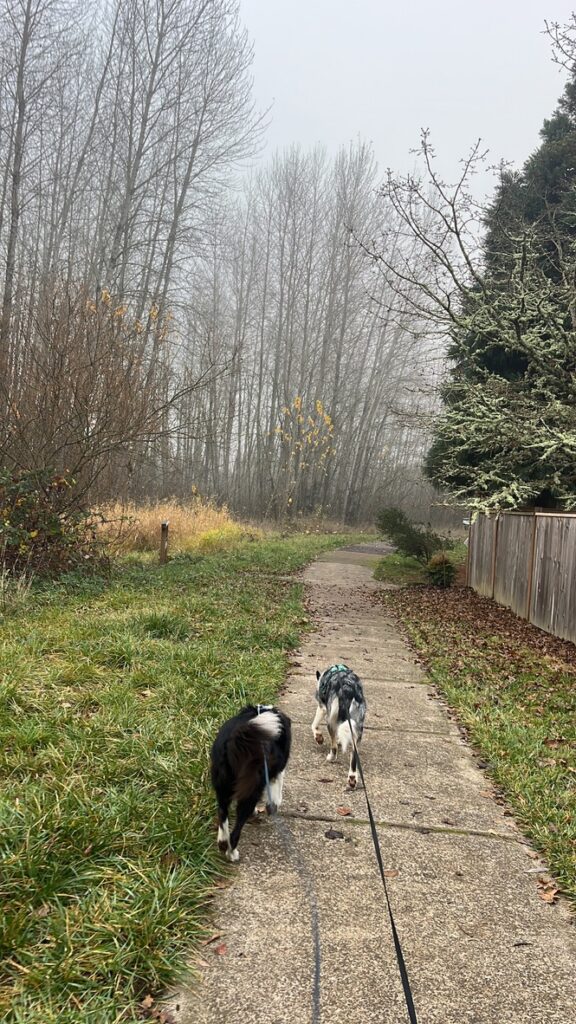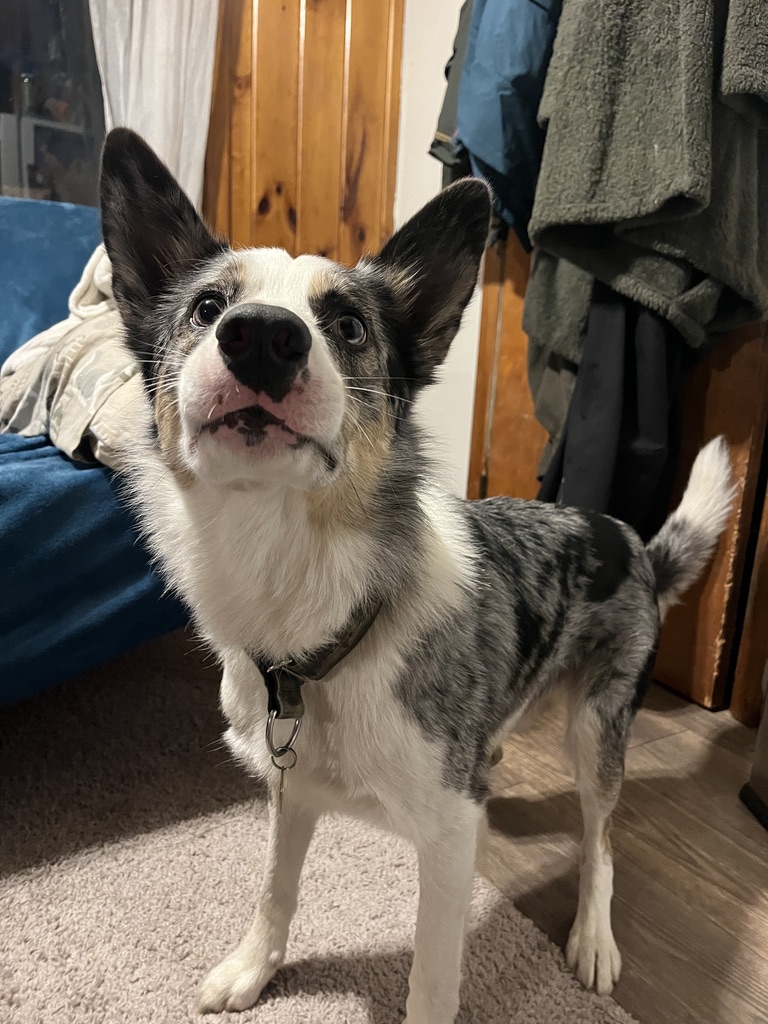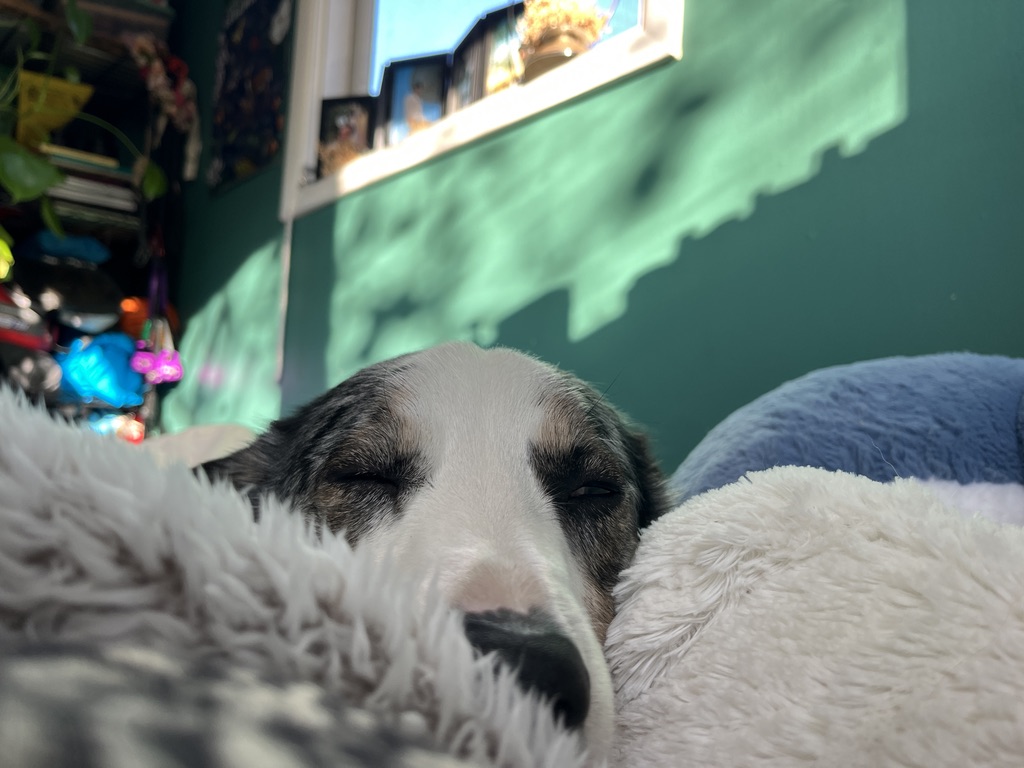“Do you have time for the veterinarian to call you at noon today to discuss Niffler’s pre-dental bloodwork?” My heart sank.
“Sure, is everything ok?” I tried to keep my tone casual.
“The vet will go over that with you.” My heart dropped right through my soles and into floorboards.
That was not a normal call to report clean findings on routine bloodwork and I knew it. It was November 13, just a week after the 2024 elections and the day after the Oregon State graduate student union went on strike. My stress was already extraordinarily high. I hardly remember stats class that morning, but I know I was on the picket line when the vet called.
Niffler has heartworm. Or, they thought he did. They were pretty sure. They’d detected microfilaria in his bloodwork when preparing him for a dental. I asked about the chance of false positives, about contamination or swapped samples; scrambling for hope. Niffler has been on preventative continuously his whole life. How could this be happening?
We agreed that I’d bring him in the next day for a different sort of test, and in the meantime they’d run his samples a second time. The dental was out of the question. I tried to stay away from Google that night but pulled out a box of Heartguard showing the stickers of faithful administration from March to November of 2024. I dug through my email for Chewy invoices and started a folder in my Google Drive.
The next day, November 14, I sat on the floor of the clinic with the vet tech as Niffler trembled from his blood draw. We watched as the instant heartworm test lines darkened. He was positive.
Dr. Mullen came to our room and explained our options. A “slow kill” method basically involved killing the eggs but letting the worms die of old age. It could take years to pull off, and my vets made it clear that this was not their preferred method of treatment due to ongoing damage to the heart from the adult worms. Otherwise we could go with the American Heartworm Society preferred method: “fast kill.”

Dr. Mullen explained that we’d start Niffler with a month of doxycycline (an antibiotic) to reduce the bacterial coating on the exterior of the worms. Then Niffler would get an injection of an arsenic derivative, melarsomine. This would be a rather nasty injection that came along with a short hospital stay and a steroid shot. A month or so later, he’d get his second and third injections with the same nasty add-ons. Theoretically, Niffler will be cleared to exercise again starting March 14. Five months.
In the meantime, starting that day, I was not to exercise Niffler. No running, hiking, biking, fetch, tug, agility, off-leash scentwork, yard zoomies, kangaroo-hopping when I get home from class. The recommendation, officially, is crate rest.
The day before we’d had a lovely off-leash search as he prepared to go to our Texas Ocelot project. We went for a 5 mile run the day before that. The day before that? A fast and furious mile bikejore.
Niffler lives for speed. He’s lean, muscular, and deep-chested. His body and brain are made to run. An all-out outrun around the park is what makes his heart sing. He is also my younger working dog; Barley turned eleven just two weeks after Niffler’s diagnosis and is circling towards retirement. Niffler is supposed to be taking up Barley’s mantle; this is supposed to be his year. His training and maturity are falling into place and I love the dog I see.
My world swam and wavered with this news. Everything else in life already felt so hard. I was barely hanging on with the PhD, K9 Conservationists, the union strike, the election, the Oregon rain and cold, the struggles of dating in 2024, and missing my “old life” living in a van on the beach.
Niffler’s exercise restrictions completely upends the fragile balance I maintained. Almost every day, I took the dogs for an off-leash run as a way to enrich them, keep them in shape for fieldwork, get us all outside, and build my endurance for upcoming cross-country ski races. Running is an integral part of our mental and physical health routine.
But if Niffler gets his heart rate or blood pressure up between now and when he’s clear of the heartworms, the foot-long worms living in his heart could cause serious complications as they die. Not to get too graphic, but these worms will disintegrate as they die. If Niffler’s heart expels those bits with force, they could cause embolisms in his lung or other nasty complications. Trust me, I went down the Google Scholar rabbit hole. It’s bad.

I have not been able to get clear answers from Google Scholar – or veterinarians – on the likelihood that Niffler will make a full recovery. Not just back to health, but back to peak athleticism. I don’t know what his aerobic capacity or VO2 max may look like. The good news is we caught things before he started to show symptoms; it’s possible that his infection is light and relatively new. That aids in his prognosis, but I don’t feel like we have much for specifics beyond that.
I built on the original Google Drive folder to put together a claim for Heartguard to pay for Niffler’s treatment. I pulled together a timeline and history of Niffler’s preventatives, lack of symptoms, diagnosis, treatment, and costs. I spent hours calling veterinarians in Montana, Colorado, Nebraska, Washington, California, Wyoming, and Texas to get every scrap of evidence I could find from our many, many field sites and related health tests. Every few days, I spoke to representatives of Heartguard on the phone. Our case manager was kind and helpful and attentive.
Our claim was denied.
I was told that you need proof of 2+ years of continuous treatment with Heartguard as well as negative tests. I have proof of 11 months of Heartguard, but don’t have records from our time in Central America. Niffler’s last negative test was 15 months before now, but the 4-month gap in receipts was enough to deny the claim.

We are 26 days out from his diagnosis. Friends, family, and people I hardly know have stepped up to send me frozen meals, chews and puzzle toys for the dogs, and gift cards for takeout (my friend Ursa made us a MealTrain page for this). With the help of Trazodone and Gabapentin, Niffler is surviving with daily leashed walks, fitness games (many similar to Penn Vet’s K9 Fit to Work), small scent puzzles, shaping games, and lots of time to shred and chew.
I don’t know for sure when Niffler contracted heartworm, though it must have been at least 6 months ago given his disease stage. We were in Central America for much of 2023; I suspect that he contracted it there rather than in Oregon or Wyoming. His last negative heartworm test was in June 2023, just 2 months before returned to the USA. I would guess he was bitten by an infected mosquito in that window. The volume and variety of bugs in Latin America don’t help our odds. Preventatives aren’t foolproof, even when given faithfully. I have several reminders for Heartguard and Barley’s Adequan injection and Bravecto and have never missed a dose.
We are hanging in there. Barley is going to go to the Texas Ocelot project in Niffler’s stead, and I’ll spend my winter going for runs and skis alone. Niffler is coming to class with me more for some low-excitement enrichment. Our dog insurance provider, Healthy Paws, will cover much of Niffler’s treatment. My advisor has offered to help cover the rest through laboratory fees; Niffler is an integral part of the team and technically functions as lab equipment in need of repair.
So it could be worse. He could be sicker. He could be suffering more from the lack of exercise. I could be on the hook for thousands of dollars of treatment.

But it’s hard. It’s really hard. Every time I put on my running shoes, Niffler is there wagging his tail and looking up at me with his huge liquid eyes. He squeaks with joy when he sees me pull out the running waist leash, which I clip to Barley before shutting the door in Niffler’s face. Every few hours he grabs a new toy and throws it at me, backs up with his booty in the air and a grin on his face, trying to get me to be fun again. Throw it. Throw it. Throw it.
Letting him down when he is so excited to go out is the worst part. His expectations and hope crush me. I may almost be a relief when the melarsomine makes him sick in a few weeks. It will be a new, different tragedy.
Some days he won’t eat. Some days he carefully dissects his hot dog and eats around his antibiotics, and I have to fish them out of the carpet and shove them down his throat as they dissolve between my fingers.
He and Barley are snippier with each other than usual. Niffler is definitely more of a pest than he’s been for years and he’s both bothering Barley. He is also uncharacteristically moody, occasionally lashing out over food or toys. I have to be more careful with toys and treats and chews than usual; household harmony is something I normally take for granted.
I will try to keep you all updated as Niffler’s treatment progresses. I’m sure we will have lessons learned regarding keeping a young, active, fit working dog quiet through these months. Hopefully we will have a smooth, quick recovery and a stellar prognosis when this is all over.
For now, please keep your dogs on preventative and keep your receipts. Don’t switch providers if you don’t have to; Heartguard won’t pay if your dog was on Sentinel or Interceptor prior to diagnosis.

 Donate
Donate
